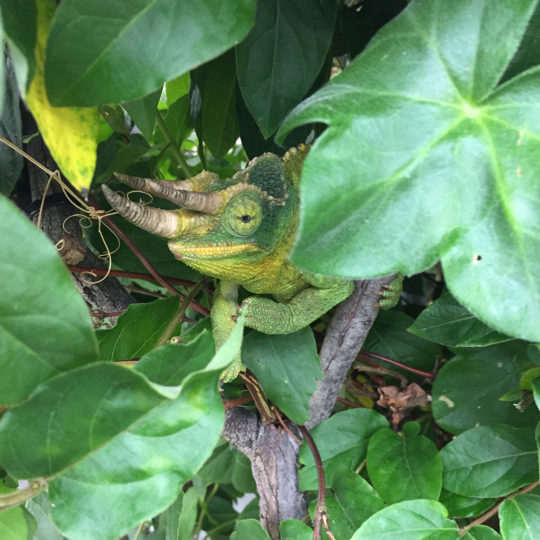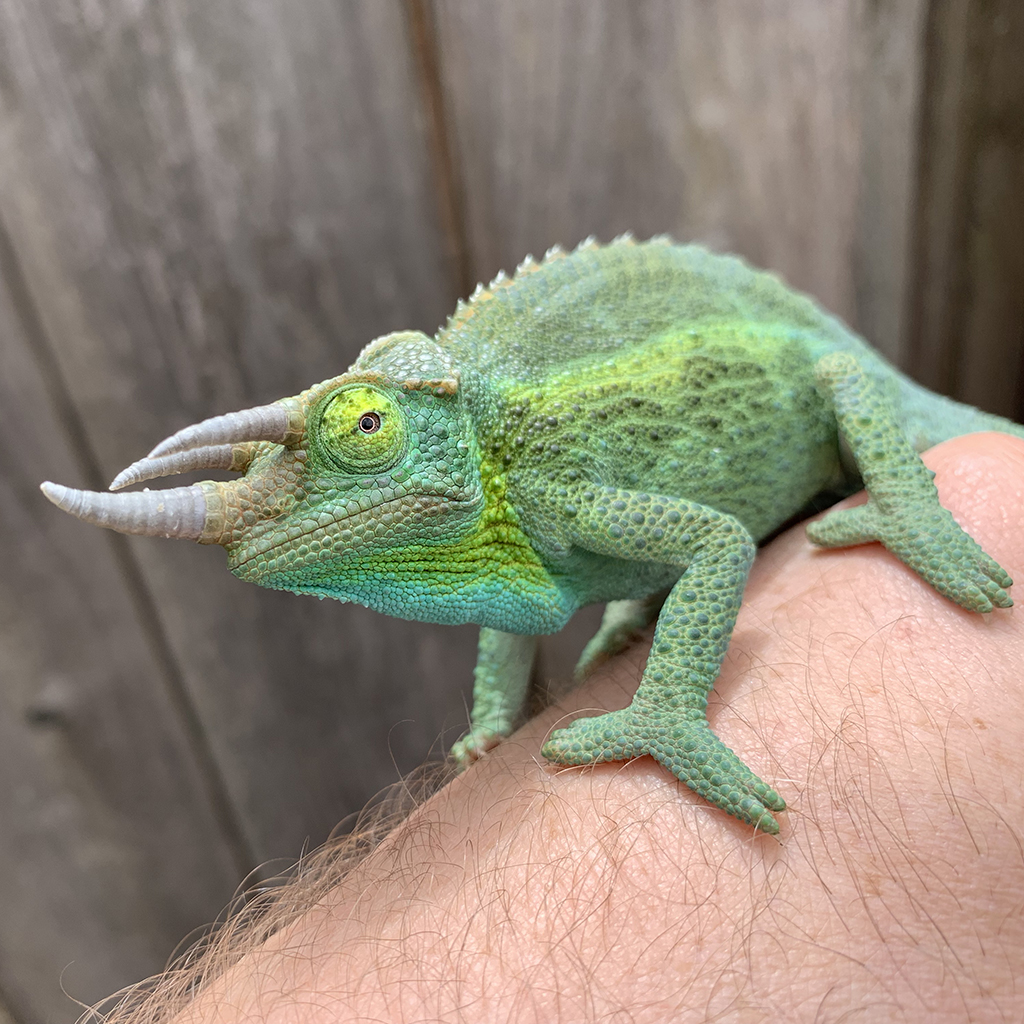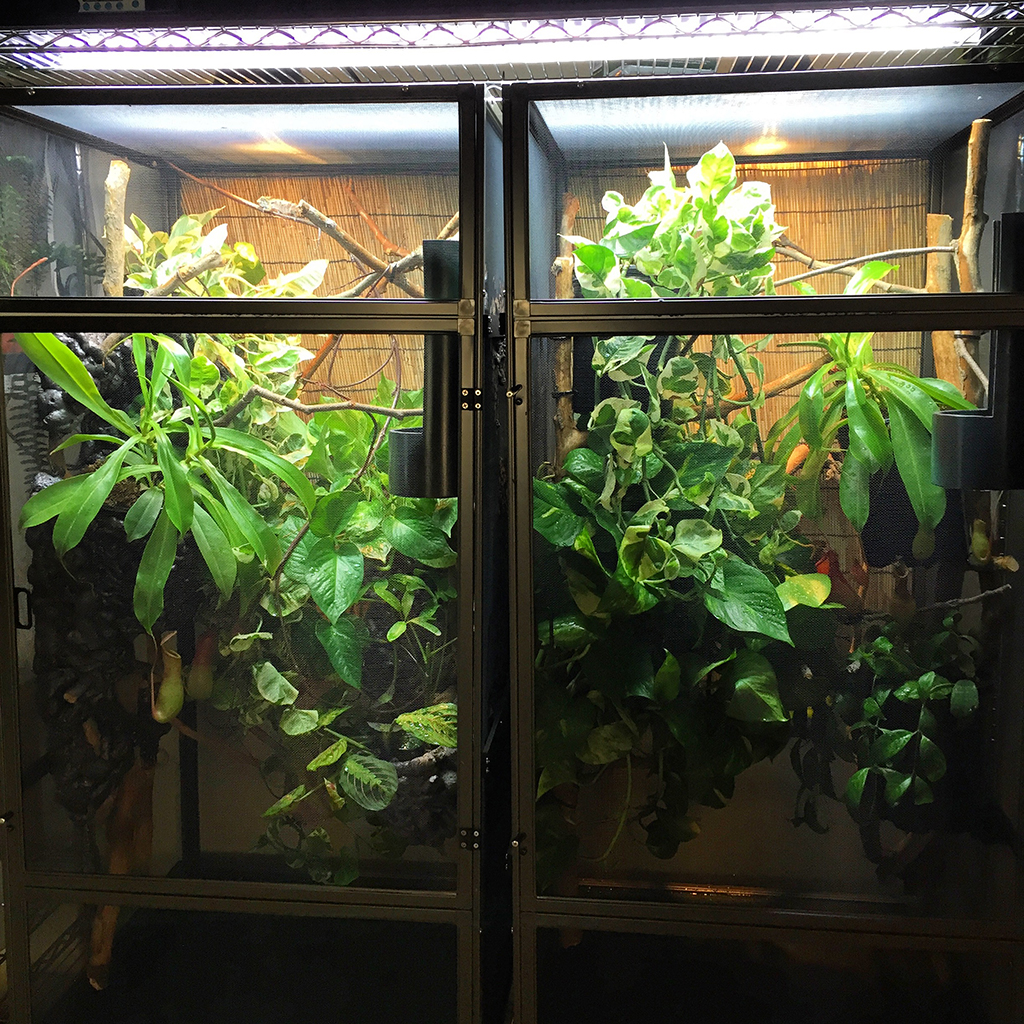Summary: Are Chameleons Good Pets
- Chameleons are not a Normal Pet – more like a fish
- Chameleons are a pet to be observed, not interacted with
- Initial investment can be between $300 and $1500
- You must be comfortable with insects
- A chameleon is not a good pet for a child
It is easy to be smitten by chameleons. From their patterns, horns, impossibly long tongue, color change, and….just all of what they are, they are truly other-worldly and have a quick charm about them. But do they make good pets? In this module we will discuss what kind of pets chameleons make. The goal is to evaluate whether what they are can align with your desires and expectations. Only with alignment will both of you have a long and rewarding experience.
Chameleons are nothing short of amazing. They are a unique collection of characteristics that make them stand out in the animal world. Their popularity continues to grow through movie appearances and social media exposure. In addition, a growing community of breeders has made robust, captive bred chameleons easily available. But, they have a life that is much different than ours. Just like any animal that has not been domesticated for thousands of years, chameleons have not been selectively bred to fit into our life patterns like a dog has. So our attitude must be to align our expectations to what they are – NOT to figure out how to bend them to our expectations of what we want them to be.
That really isn’t what we want to hear! Believe me, I would love to tell you that a chameleon can tame down to be a shoulder pet. Wouldn’t that be cool? But this is not realistic and the best use I can put my 40 years of studying and keeping chameleons to is to help you see what chameleons truly are.
Do chameleons make good pets? Well, that entirely depends on your expectations. So hang out here for a little while and get a feel for what they are like.
You can watch a summary of the topic of chameleons as pets here!
An Introduction to the Author

But first, it is important that you know where this information is coming from. My name is Bill Strand. I have been studying, keeping, and breeding chameleons since my first chameleon 40 years ago. So what I share comes from a deep level of experience. I am not satisfied with just what works, but am constantly testing and pushing our husbandry forward. In 2015 I began the Chameleon Breeder Podcast with the intention of learning from experts around the world. In this, it succeeded beyond my wildest dreams! Over all these years I have talked to the world’s top chameleon keepers, breeders, scientists, and veterinarians about a multitude of chameleon topics. Since before the podcast even was an idea I knew I wanted to compile all the information and experience I had gathered. I had the website domain and was ready to start the Chameleon Academy way back then. But I elected, instead, to pour my efforts into answering the questions I still had. Five years later I still had questions but it was time to launch this Chameleon Academy. So in 2019 this website was launched. I changed the name of the podcast to the Chameleon Academy Podcast and am putting efforts into the video arm of the Chameleon Academy outreach.
My mission is to encourage and promote the type of chameleon care that will lead to a long and healthy life for your chameleon. To do this I strive to make the necessary information available so you can succeed. But more than just telling you what you should do I put great effort into teaching you the “why” behind it so you can understand the reasons and make this knowledge your own.
I will be straight with you and tell you how much we know, how much we are guessing on, and what we need to figure out. Chameleon husbandry is a fluid subject and we are learning more every year. So this website is under constant update. It is an exciting time and I welcome you to the chameleon community!
Why chameleons are not a normal pet

There is nothing like a chameleon. With those independently moving eyes, impossibly long tongue, color changing ability, horns, and unreal colors this is obviously a unique creature. And the thought that we could have one as a pet is amazing! I wish I could say that your pet chameleon will be your best little dragon friend traveling around on your shoulder. I’d like that myself! But, alas, they, like every living organism on this Earth have adapted to their environment and their kind’s social structure. And this life of their’s is completely foreign to us humans!
If we want to keep chameleons healthy and happy we must learn about their life and how we can recreate it so they can live with what they need. The fact that you are researching this website is a great sign that you will be able to make an informed decision as to whether you and a chameleon will be a good match. Please read carefully as chameleons are specialized animals and require conditions that are not intuitive to us humans. They also are not good traditional pets so they require you to put aside visions of a pet dragon on your shoulder and embrace something more similar to keeping a living piece of art!
One thing to get out of the way up front is that you will be getting familiar with insects. Chameleons require live insects as food and that means you will be bringing live “feeder” insects into your home and taking care of them. Usually, the gutloading process (which will be explained later) takes 48 hours so you will be learning how to take care of chameleons and their food! And it is a personal growth area. When my wife started helping with taking care of the chameleons she would flinch every time a superworm squirmed the wrong way. Now a days, she has taken over the superworm breeding project because she “knows better” how to take care of them. So, yes, it does grow on you! And, honestly, it becomes a lot of fun to work with insects!
What a chameleon is like as a pet

Chameleons like to be left alone. This is the one characteristic that we all have to accept. There are people that refuse to accept this and this leads to a shorter life for their chameleon. If you want to make your chameleon happy, walk by its cage and pretend you didn’t see him. That is the kind of pet a chameleon makes. Chameleons do not like to be held or played with. They do not want to interact with humans. Unfortunately, they cannot speak so keepers that do not know chameleon body language project their desires onto the chameleon and talk about how their chameleon loves them and loves to come out and play. I run some Facebook groups and we see this over and over again. These chameleons are stressed out and the keeper thinks they are “animal behaviorists” or “all animals love me” so cannot accept that there are animals that do not think like humans.
If you decide to bring a chameleon into your life you are signing up for creating a densely planted vivarium and a chameleon which may spend much of its time hidden. Ideally, you do not hold your chameleon. Chameleon keeping is less adding a stuffed toy to your collection and more opening up a view into an alien world. Chameleon keepers become researchers and the more we learn about chameleons and their care the more we learn about the world. And every answer generates three more questions. It is an exhilarating part of my life and after 40 years since my first chameleon I am still digging deeper and find out more about this world while my tree dragon looks on from behind their leafy hideout.
This isn't what we wanted to hear....
Now, I know this is an immediate turn off for many people. When we started we all had visions of interacting with chameleons on a human level. Not many of us got involved with chameleons with the idea we were going to put aside our vision for this fantastic relationship. But reality hold a different direction for us. It is safe to say that many people will not want to realigned their vision and will. instead, simply seek out someone who will tell them what they want to hear. If this is you I ask that you give me a little bit more of your time to share how learning what a chameleon is and respecting what they truly are can lead to a greater and deeper long term fulfillment. This has been an incredible experience and I hope to share that with you.
Okay, then what do keepers do with their chameleons?
Mostly, we enjoy watching them! We put great effort into creating a beautiful cage environment that is full of life. The plants grow as your chameleon grows and it soon turns from something you created to something you are watching be created before your eyes. It is a peaceful, calming activity.
Now, this doesn’t mean there is no interaction. Your chameleon will grow comfortable with you. They can tell the difference between people and they will know you are the one that brings their food. Most chameleons will get comfortable enough with you that they will eat out of your hand. And this is the level of interaction I choose to have with some of the more calm of my chameleons. Handling is not out of the question with some of the more outgoing chameleons, but I only take a chameleon out of the cage if they crawl onto my hand themselves. There are precious few that do this, but there are a couple. The important thing is that it is 100% their choice. You can’t predict which ones will do this and you can’t just take back the 98 out of 100 that won’t do this. So you have to be okay with accepting whatever your chameleon grows into being. If handling is an important part of your pet experience then a chameleon is probably not the right pet for you. It would be best to find a pet that is more inline with what you are looking for. This is best for both you and the chameleon which will live a life of stress as it is being forced to live a completely foreign lifestyle.
The cost of keeping a chameleon
The biggest cost in keeping a chameleon is the initial set up. I caution you against cutting corners here. A chameleon with a proper cage, lighting, and misting system will be a low maintenance pet. But the initial cost can be eye opening.
Used equipment and looking for sales can reduce this cost dramatically. A starting budget for a baby veiled chameleon from the last day of a reptile show could get you into chameleon keeping for $300 USD. Getting a top pedigree panther chameleon with the largest cage commercially available and the top misting and light system could push the cost to above $1500.
Maintenance can run about $43 a month if certain annual expenses are spread out over the year. These include a vet visit and UVB light bulb replacements. Of course, this is an estimate and some of these items may be more or less expensive for you depending on where you live and how tenacious you are in searching out deals!
The important things to remember are
- Do not cut corners up front. Whatever you save in the beginning due to cutting corners you will pay many times over in vet bills or shortened chameleon life
- Get everything set up ahead of time. If you are on a budget then get one piece of required equipment a month and make the chameleon your last purchase
- Do not value your chameleon based on how much you paid for it. Each chameleon is a living creature and deserves a good UVB lamp and a vet visit when sick. Please do not get a chameleon unless you can afford the proper equipment and regular maintenance.

How much time is required to take care of a chameleon?
Taking care of a chameleon is not time intensive, but it does require daily attention. You will need to feed either every day or every other day depending on the age of your chameleon. The bottom of the cage needs to be cleaned. This often is quite quick as chameleons do not make much of a mess.
Watering can be time intensive if you do not get an automatic mister. This could be 10 minutes of spraying a couple times a day. I highly suggest getting an automatic mister!
The hidden time that is usually not considered is the time spent taking care of their food. The insects they eat must be gutloaded and kept healthy so there is actually feeder insect care time included and this can be anything from making up a simple salad for the crickets to eat for 48 hours before feeding to actually breeding feeder insects.
One thing that must be considered is your travel lifestyle. Chameleons will not miss you while you are gone, but you will be working a little harder finding a pet sitter that cares for both chameleons and their food.

Kids and chameleons
This is a tricky question which can only be answered by the parent. There are certain kids which watch the world with amazement and seek to learn its secrets. This child will do well with chameleons. There are children that blast through their world larger than life. This child may not be suited for the shy chameleon. In the end, what you as the parent must embrace is that a chameleon (and actually every pet) is not a good thing for a child. That said, a chameleon is a great pet for an adult with a child. What this means is that if you commit yourself to take care of the chameleon then, yes, you will have a positive experience. Your child will learn what it means to take care of another living being by watching you and will have their lives enriched by exposure to this bizarre creature. Both children and adults get tired of the same routine every day, but an adult has the ability to force themselves to go through the motions even when they do not feel like it. That is why we adults can keep pets! We realize that it doesn’t matter what we feel like. Our pet must get food and water!
Chameleon keeping is a great tool for you to show your child what responsibility looks like through your example. But
Bottom Line. Whether it is you or your child that wants the chameleon it can be a very positive and educational experience if you accept that the chameleon is your pet and you maintain 100% responsibility. My children have been around chameleons their entire life. They do not realize how special that experience is until they talk about it with kids that have only read about chameleons. Considering how much is involved in learning, the chameleon world it is definitely a great pastime that will enrich both you and your child. So, yes, a chameleon is a great pet for a child to watch their parent take care of! It just isn’t a good pet for a child to be solely responsible for. If your child is interested in a chameleon then this website will be the perfect class structure for you and your child to work through together. Talk about what is written here and use it to see how interested they get. If this website excites them and they ask more questions you have a good chemistry. If your child is bored with learning more then a chameleon may not be the right next step!

Other pets
If you already have other pets you’ll need to do some planning as to where your chameleon cage will be. Chameleons will not like the animals we humans often keep around us. Dogs, cats, Parrots, and little kids are all potential predators and will stress your chameleon if they are in visual range.
You will need to arrange things so that cats cannot climb onto the cage and nap there. Dogs are easier as they usually are just running back and forth. Chameleons may be able to totally ignore these fur things rummaging about if the chameleon’s cage and highest perch are paced far above the action. Birds are a natural chameleon predator so the chameleon should not be able to see any pet bird larger than itself. The simplest approach is to ensure that current pets are not able to be seen by your chameleon.
A special note is that chameleons will not get lonely. Putting two chameleons together in a cage is not a good idea. We will definitely go into this in more detail later as pet stores and reptile show vendors often try to sell chameleons as pairs and say they can be kept together. This is simply not true.

How your life will need to change
After the initial purchase of the chameleon and the integration of maintenance chores into your daily life there are just two main considerations. The first is that chameleons eat insects. These insects must not only be alive, but nutritious. This means that you are not just dumping bugs from the pet store in the cage, but that you are keeping insects for 48 hours. Not only are you keeping insects, but you are feeding them and making sure they have the best care. You will have to be comfortable around insects.
The second is time. With daily maintenance required, vacations will need some thought. It is more challenging to find someone who will watch over your chameleon while you are gone!
The biggest change is that you will find is that there seems to be an endless amount of information to absorb and understand about chameleons. You will be continuing to learn for your entire time keeping chameleons.

The perfect chameleon keeping candidate
Chameleons are a link back to nature. The perfect chameleon keeping candidate will be one that is wanting to recreate a chameleon environment so they can bring out as many natural chameleon behaviors as possible rather than force a chameleon to adjust to the human world. Chameleons do best with keepers that are content to keep a distance and watch.

Navigation
This seminar is part of the introductory course Chameleon Basics which, in turn, is a module within the even larger Term 1: Getting Started With Chameleons.




